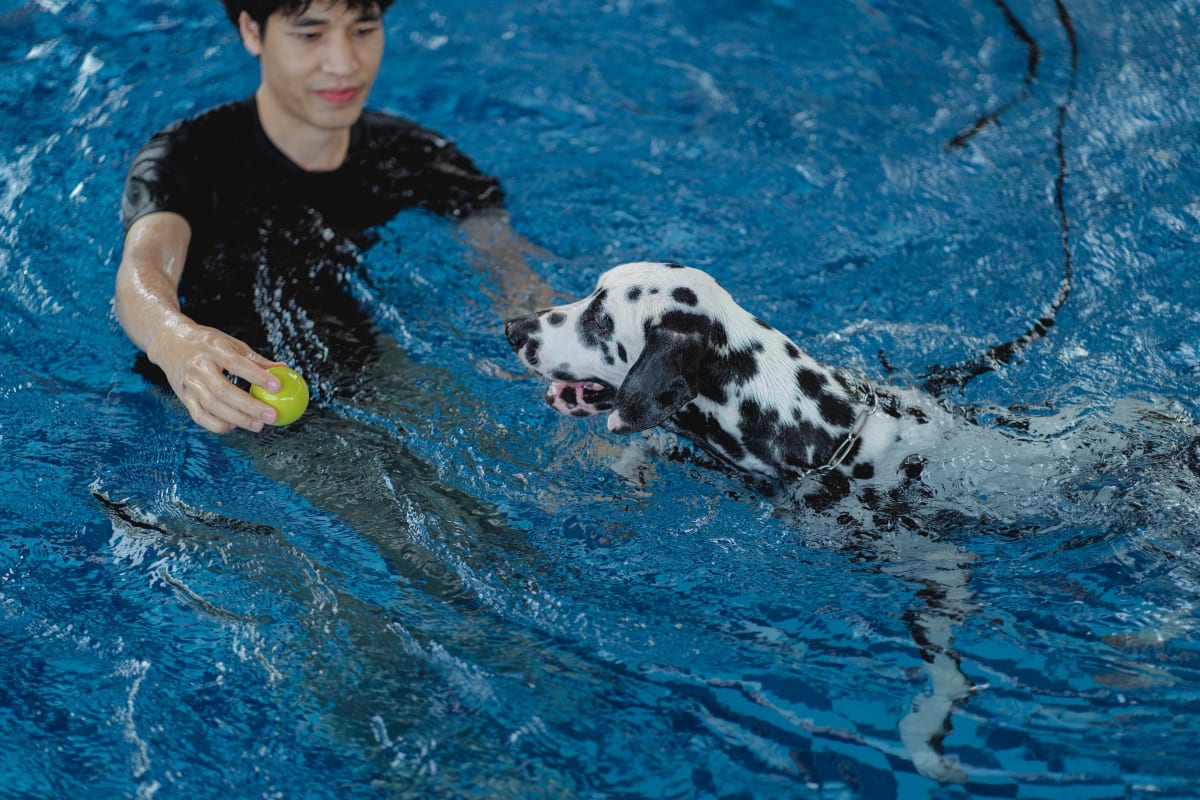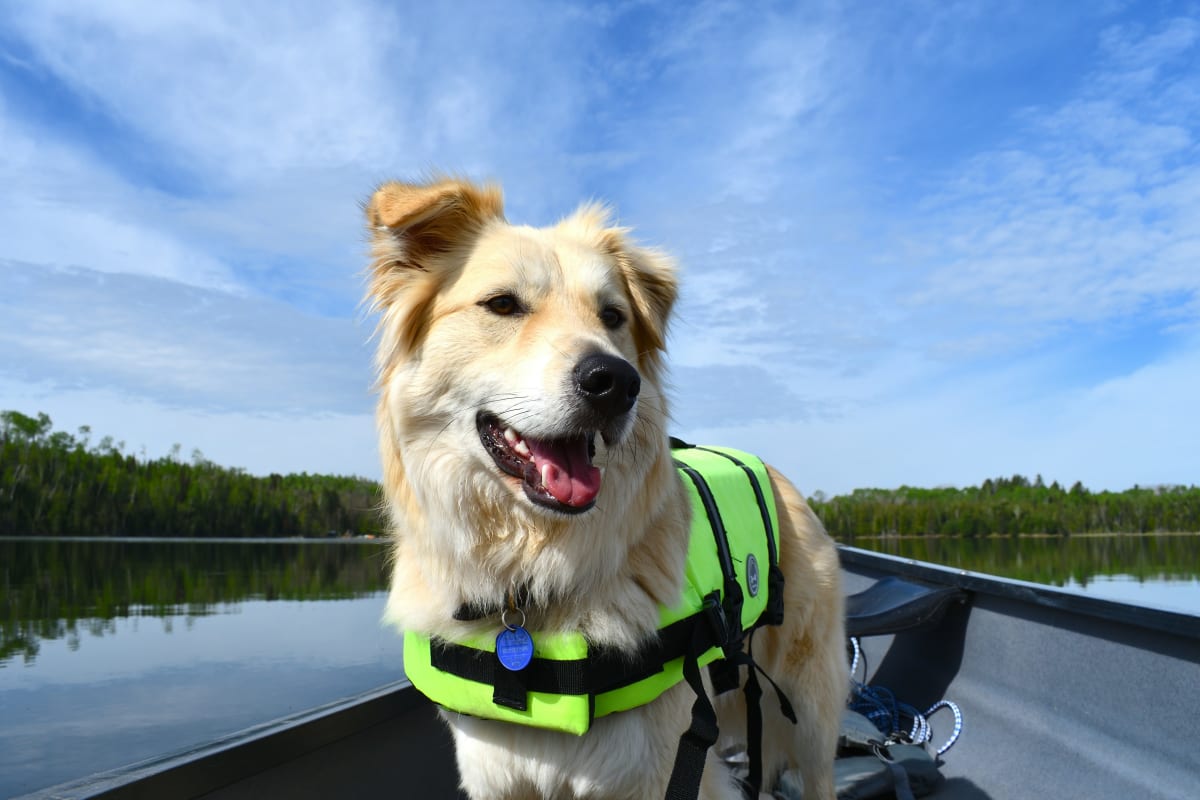Lots of dogs enjoy swimming and playing in pools with their owners. If you have a dog that loves to cannonball in the pool with you, you might be wondering if it’s okay for your dog to be paddling away by your side. While there are measures you need to take to keep your dog safe while swimming, the effort is well worth it to ensure your dog is protected and comfortable before, during, and after splashing around in the pool.
Teach Your Dog How to Swim
 It’s unsafe for owners to throw their dogs into pools and assume that swimming will be innate. This can be really dangerous as not all dogs enjoy swimming or are able to swim. In fact, researching your dog’s breed and best swimming practices is advised as some breeds cannot swim due to their build.
It’s unsafe for owners to throw their dogs into pools and assume that swimming will be innate. This can be really dangerous as not all dogs enjoy swimming or are able to swim. In fact, researching your dog’s breed and best swimming practices is advised as some breeds cannot swim due to their build.
Dogs that are inexperienced swimmers will try to use just their front paws to swim. You can help teach your dog to swim by holding the back end of its body until it learns to use both its front and back legs. Similarly, you can notice your dog is struggling to swim by watching its back end. If your dog’s back end begins to dip and they are mainly swimming with their front legs, it’s time to give them a break on land.
Show Your Dog How to Enter & Exit
Let your dog enter at their own pace when they’re ready, praising and encouraging your pup each step of the way. You can further encourage your dog to enter the pool by going in first yourself and bringing toys along. However, do not force a dog to go in the pool if they don’t want to.
Because there are few points of entry and exit that are accessible to dogs, getting out of the pool can be difficult for your pup. It’s best to have an easy way for your dog to enter and exit the pool such as shallow steps or a ramp. Any dog swimming in an unfamiliar pool should be shown beforehand where they can get out. Letting a dog swim in a pool without showing them how to exit can tragically make a dog more susceptible to drowning as they aren’t familiar with how to escape.
Pool Chemical Safety
 Dogs are able to swim in pools with chlorine but should never be allowed to drink the pool water. Keeping a dish with clean water out for your dog will help deter them from using pool water to stay hydrated. Additionally, chlorine can make your dog’s skin dry and irritated so it’s a good idea to inspect them for signs of discomfort and sensitive areas. Some owners may notice a slight change in the color and softness of their dog’s coat. This is a typical side effect of dogs swimming in pools but as long as your dog’s skin isn’t overly dry and irritated, this isn’t a cause for alarm.
Dogs are able to swim in pools with chlorine but should never be allowed to drink the pool water. Keeping a dish with clean water out for your dog will help deter them from using pool water to stay hydrated. Additionally, chlorine can make your dog’s skin dry and irritated so it’s a good idea to inspect them for signs of discomfort and sensitive areas. Some owners may notice a slight change in the color and softness of their dog’s coat. This is a typical side effect of dogs swimming in pools but as long as your dog’s skin isn’t overly dry and irritated, this isn’t a cause for alarm.
When it comes time to clean your pool, do not let your dog outside with you. This will help prevent your dog from coming into contact with and ingesting chemicals. It’s vital that you store pool chemicals in a locked location where animals and children cannot get into them.
Be Cautious of Dry Drowning
Dog owners should be aware of dry drowning, also referred to as secondary drowning, which is a condition that can affect all animals and even people. Dry drowning can happen when a dog becomes exhausted while swimming, begins to struggle, starts to panic, and accidentally inhales a large amount of water. This water may then enter the dog’s lungs, creating serious issues that can be fatal.
Signs you should take your dog to an emergency animal hospital for possible water inhalation include coughing, chest pain, trouble breathing, breathlessness, and non-characteristic inactivity. Symptoms may not show up right away so if you suspect your dog inhaled lots of pool water you should take them to an emergency vet right away.
After Swimming Care
To help reduce the risk of your dog’s skin being irritated from pool chemicals, rinse off your dog each time it finishes swimming. Likewise, the material of the flooring around pools can be rough on your dog’s paws, so their paws and nails should be inspected for any tearing or bleeding.
Finally, dry and clean your dog’s ears to protect against infections. This is especially important if your dog has floppy ears as you don’t want moisture to become trapped in them. Drying off your dog and removing any water-soaked items like a collar or life jacket will help keep them comfortable and free of rubbing.
Added Precautions
 Canine Life Jackets
Canine Life Jackets
Buying a life jacket for your dog is highly recommended. There are many kinds to choose from, but it’s best to go with a life jacket that has a handle on the top so you can pull your dog out of the water if needed. Whether your dog doesn’t swim or loves the water, having your pup wear a life jacket around pools and bodies of water is encouraged.
Pool Alarms & Fences
Setting up pool alarms will help alert you if your dog accidentally falls into the pool. In addition to installing a pool alarm, putting a fence around the pool can prevent accidents or unsupervised swimming from occurring.
Pool Covers
When choosing a pool cover you should avoid floating covers. These covers are dangerous as children and animals can get stuck underneath and are unable to escape. Dogs can easily fall in after trying to walk on a floating pool cover since it can look like solid ground. After falling in with the pool cover, it’s near impossible for your dog to get back out. A safety pool cover made to withstand animals and people walking on it is the best choice.
Hot Tubs
While your dog can do laps in the pool, you should not let your dog take a dip with you in the hot tub. Hot tubs are too hot for dogs to handle and can lead to overheating and heat stroke since they are underwater and unable to cool themselves down. Time spent in a hot tub may do wonders for you but will have the opposite effect on your dog.
Always Supervise Your Dog Around Pools
 Under no circumstances should your dog swim in a pool without supervision. Even if your dog loves swimming, is wearing a life jacket, and has years of experience, they can still tire themselves out and struggle to leave the pool. You need to keep a close eye on your dog as well to make sure they aren’t drinking the pool water and don’t inhale a large amount of water that could lead to dry drowning.
Under no circumstances should your dog swim in a pool without supervision. Even if your dog loves swimming, is wearing a life jacket, and has years of experience, they can still tire themselves out and struggle to leave the pool. You need to keep a close eye on your dog as well to make sure they aren’t drinking the pool water and don’t inhale a large amount of water that could lead to dry drowning.
Not only does your dog need to be supervised when in the pool, but your dog should be supervised when they are outside of the pool too. Because they are still near the pool, you need to keep an eye on your dog to make sure they don’t accidentally fall in or try to take a drink. Even if you are just letting your dog out for a quick run around the yard or bathroom break, you still need to make sure they are safe and stay away from the pool.
Dogs' reactions to swimming in pools will change depending on the dog. Some dogs may do fine with chlorine while others will have more sensitive skin. Remember to always supervise your dog around pools and if they don’t enjoy swimming or the chemicals are too much for them, don’t force them into the pool.
Overall, you know your dog best. If something doesn’t seem right after they’ve been swimming, contact your dog’s vet. Now that you know how to keep your dog safe in the pool, grab some toys and enjoy splashing around in the sun with your pup!
Check out new arrivals on Lancaster Puppies and stay up to date on canine care with our blog.

